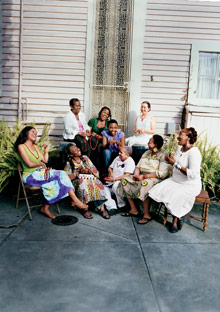
Photo: Katherine Wolkoff
See below for identification
See below for identification
A levee breaks, and suddenly artists all over New Orleans are forced to rebuild their lives. Half a world away in Rwanda, survivors still fight every day to move beyond the genocide that wiped out nearly one million people. Now women from both countries are making friends, money, and the ultimate fashion statement. Introducing a brand-new O Bracelet!
On a muggy Saturday morning last May, 24 women showed up at the Stella Jones Gallery in downtown New Orleans. They were African-Americans mostly, from girls barely out of their teens to "been there, honey" grandmothers, almost all dressed in tennis shoes and jeans topped off with a bossy pair of earrings. Some came family-style—small clans of mothers, daughters, cousins, aunts—while others arrived arm in arm as teams of friends; all of them artists, carrying bag lunches and cups of take-out coffee, ready for a day of work and gab.
Inside the gallery, the women greeted one another and went off to find jewelry needles—thin wires with a flexible loop at the end—which they'd be using to thread beads with all day. Then they took their places at long folding tables set with bowls and cardboard egg cartons full of round turquoise beads and glittering citrine crystals, bone tiles of zebra-striped batik and nuggets of blazing-red coral. As the conversation jumped between their two favorite topics—food and men—the women sorted through the bowls and egg cartons, picking out beads as though at a buffet.
Stella Jones herself was dressed in trusty straightforward solids, blouse over slacks, silvery Avia sneakers, and, of course, the earrings—$2 white metal hoops. To create this gathering, she had recruited artists from all over the city. Four years post-Katrina, many of the women were still living in temporary homes. Half of them were jobless. But on this day they had a triple purpose—to earn a little money, to welcome two honored guests, and to help make something special: O Bracelets.
See the bracelets
If you own an O Bracelet, thank you: Our four previous editions were crafted by East African women who, for their labor, earned up to 12 times their average daily wage—money that has put food on their tables, sent their kids to school, and paid for the installation of clean water systems in eight villages. Now with the fifth edition, we decided, along with our partner Fair Winds Trading, not only to continue our work in Africa but to extend the project to women in our own country. We chose New Orleans for our home base because, with its rich history, love of jazz, and carnival traditions, it is in many ways the most African city in America.
We also chose a design with two distinct parts to reflect both groups of women coming together: Each bracelet has a patterned disk that sits on the wrist like a watch face, and a beaded band. Stella is managing the beading process in New Orleans, while the disks have been woven by 250 women in Rwanda under the direction of one of today's guests, Janet Nkubana. A champion of improving life for rural African women, Janet has come to Stella's gallery along with a young Rwandan weaver she's trained, Brigitte Nyampinga. They're here to hand off the disks in person and spend a week making bracelets with the local beaders—some of whom are also painters, quilters, sculptors, and textile artists, and one of whom, Rukiya Brown, makes dolls.
Pictured above: After a day of making jewelry together, two visitors from Rwanda bond over a joke with their hosts in New Orleans. Back row, from left: Stella Jones, Asante Salaam, Brigitte Nyampinga (from Rwanda), Beatriz Soco Ocampo. Front row: Chanell Gautreaux, Rukiya Brown, Cely Tapplette-Pedescleaux, Janet Nkubana (also from Rwanda), and Ausettua Amor Amenkum.
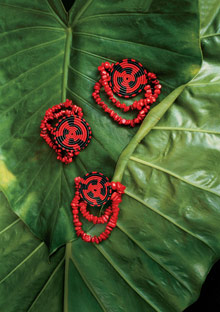
Photo: Katherine Wolkoff
Dressed in a billowy shift from Cameroon covered with a chunky jumble of beads and silver, Rukiya has arrived looking more African than the Africans. As it turns out, most of the women in the room have never been to Africa, which is why several say this project is perfect for them. In fact, much more than the prospect of earning some extra money, what moved them to participate was the chance to connect to their roots—to something that can't be ripped away by a storm.
At one point, as she works, Rukiya looks down at the gallery's concrete floor, which has been signed and drawn on by visitors. Under her feet someone has written: "Keep showing us who we are—and who we can be."
---
The daughter of sharecroppers, Stella Jones grew up in Houston sleeping three to a bed. Every Sunday she and her six brothers and sisters would pile into the family's green Chevy and arrive at church smelling like gasoline because the car was so old it had a hole in the floor.
As a young woman, Stella worked her way through a pharmacy degree ("Whites were not ready to accept me as a pharmacist—they threw the medicine back through the window," she says matter-of-factly), followed by a master's degree in public health and an MD at Texas Tech. Along the way, she married and had two children. She moved to New Orleans in 1976 when she started her ob-gyn residency at the sprawling old Charity Hospital—such a medical abyss, she says, "they not only had RANDO procedures (Residents Ain't Never Done One), but they also had SANSO (Staff Ain't Never Seen One)." The pace at Charity was intense. It was nothing for Stella to deliver 30 babies in a day—you could tell how many by the number of times she'd rolled up the cuffs on her scrubs, since between births there was no time to change.
The work didn't ease when she opened her own practice on Tulane Avenue, which mainly served disadvantaged black women—often there was a line out the door, and they came to her not just for medical treatment but for help with all their problems. Though by now Stella and her husband had four children, and she was busier than ever, she loved treating her patients. But over the years, the difficulty of their lives began to wear her down—especially the violence they lived with as New Orleans's crime rate spiked in the mid-1990s and the city became known as the murder capital of America.
"There are days that you don't forget," Stella says. "And I will never forget the day in 1995—I'd been up all night with a difficult delivery, and my nurse met me at the door and said, 'You're not going to believe who's in room 3.' It was the mother of a boy who'd just been killed. I thought, "Well, fine, I can handle that." But then she said, 'Let me tell you who's in room 4.' I asked who, and she said Mrs. So-and-So. 'It was her son who did the killing.' And I just stood there, thinking, 'Nothing has changed. It's time for me to go.'"
At one point, as she works, Rukiya looks down at the gallery's concrete floor, which has been signed and drawn on by visitors. Under her feet someone has written: "Keep showing us who we are—and who we can be."
The daughter of sharecroppers, Stella Jones grew up in Houston sleeping three to a bed. Every Sunday she and her six brothers and sisters would pile into the family's green Chevy and arrive at church smelling like gasoline because the car was so old it had a hole in the floor.
As a young woman, Stella worked her way through a pharmacy degree ("Whites were not ready to accept me as a pharmacist—they threw the medicine back through the window," she says matter-of-factly), followed by a master's degree in public health and an MD at Texas Tech. Along the way, she married and had two children. She moved to New Orleans in 1976 when she started her ob-gyn residency at the sprawling old Charity Hospital—such a medical abyss, she says, "they not only had RANDO procedures (Residents Ain't Never Done One), but they also had SANSO (Staff Ain't Never Seen One)." The pace at Charity was intense. It was nothing for Stella to deliver 30 babies in a day—you could tell how many by the number of times she'd rolled up the cuffs on her scrubs, since between births there was no time to change.
The work didn't ease when she opened her own practice on Tulane Avenue, which mainly served disadvantaged black women—often there was a line out the door, and they came to her not just for medical treatment but for help with all their problems. Though by now Stella and her husband had four children, and she was busier than ever, she loved treating her patients. But over the years, the difficulty of their lives began to wear her down—especially the violence they lived with as New Orleans's crime rate spiked in the mid-1990s and the city became known as the murder capital of America.
"There are days that you don't forget," Stella says. "And I will never forget the day in 1995—I'd been up all night with a difficult delivery, and my nurse met me at the door and said, 'You're not going to believe who's in room 3.' It was the mother of a boy who'd just been killed. I thought, "Well, fine, I can handle that." But then she said, 'Let me tell you who's in room 4.' I asked who, and she said Mrs. So-and-So. 'It was her son who did the killing.' And I just stood there, thinking, 'Nothing has changed. It's time for me to go.'"
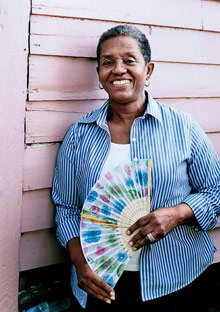
Stella Jones, gallery owner;
Photo: Katherine Wolkoff
Photo: Katherine Wolkoff
After attending to the two women and all her other patients that day, Stella took her degrees down off the wall, stashed them in the back of her banged-up gray Toyota Corolla, and drove away.
The next year, she opened the Stella Jones Gallery. When Katrina destroyed her home—a stately white-brick, five-bedroom that's still gaping and gutted—the gallery survived. In New Orleans, it is the place to buy African-American art. And after the Rwandans show up, it is the place to bead.
---
When Janet Nkubana arrives in New Orleans, she has part one of the bracelet project with her: 1,000 patterned disks made of tightly coiled sisal wound with rayon thread (Rwandan silk was deemed too fragile for daily wear). The other 7,000—the women intend to make 8,000 O Bracelets—are headed this way, too, soon to be shipped from Rwanda. The disks are traditionally used there as tops to milk jugs—milk being a cherished part of the Rwandan diet. When Janet was a girl, she says, her mother used to send her off on a day's walk to find cattle farmers who'd let her fetch water or clean up cow dung—whatever work they needed—in exchange for a jug of milk. The jugs were made of dried gourds; if dropped, they broke. "Sometimes on the way back, you'd stumble," she says. "And then you'd just sit down in the middle of the road and cry because the milk was spilled." She laughs. "Yes, we had that saying, too."
Janet, a Rwandan, grew up in a refugee camp in Uganda—was actually born on the way to the camp in 1963 as her parents fled their country during a wave of ethnic violence against the Tutsi minority. The contrast between her life now, at 45, and her "humble beginnings" (which she refers to as fondly as if they were beloved pets) never fails to inspire her. What the family of 12 had to eat—which wasn't enough—they shared from a single saucepan. The only privacy in their drafty hut was afforded by her mother's dress, which she would unwrap from her body at night and hang as a curtain to separate herself and her husband from the ten children. But when Janet was 13, she got on a bus in her first pair of shoes and headed, courtesy of a scholarship, to one of Uganda's best boarding schools. And although the "rich men's children" teased her there, she was a quick study to a better life.
In 1994, when she heard about the genocide going on in Rwanda—100 days during which the country's Hutu ethnic majority killed nearly a million people, mostly Tutsis—Janet was 30, working in a restaurant in Kampala, and raising four children. She'd been through Idi Amin's brutality and now found herself struggling in her marriage. Not only could her husband be violent, but he was also having an affair with the babysitter. "When I found out, I was hot beyond talking," she says. She packed her bags to go "home"—back to Rwanda, the homeland she'd never seen. She was tired of being a refugee.
Soon she was living in Kigali, Rwanda's capital, which the genocide had turned into a city of desperation; the killing was over, but you could still trip over a skull or a body on the street. Janet got a job managing a rundown hotel, and began scrounging food for the hungry women who constantly came asking for help. "It was so hard to see these women begging, to see them suffer with no dignity," she says. "But then, instead of empty hands, they started coming with baskets they had woven." To encourage them, Janet opened a little shop in the hotel to sell their goods. Her older sister, Joy Ndungutse, quickly saw the potential and said, "Come, let's run a business."
The next year, she opened the Stella Jones Gallery. When Katrina destroyed her home—a stately white-brick, five-bedroom that's still gaping and gutted—the gallery survived. In New Orleans, it is the place to buy African-American art. And after the Rwandans show up, it is the place to bead.
When Janet Nkubana arrives in New Orleans, she has part one of the bracelet project with her: 1,000 patterned disks made of tightly coiled sisal wound with rayon thread (Rwandan silk was deemed too fragile for daily wear). The other 7,000—the women intend to make 8,000 O Bracelets—are headed this way, too, soon to be shipped from Rwanda. The disks are traditionally used there as tops to milk jugs—milk being a cherished part of the Rwandan diet. When Janet was a girl, she says, her mother used to send her off on a day's walk to find cattle farmers who'd let her fetch water or clean up cow dung—whatever work they needed—in exchange for a jug of milk. The jugs were made of dried gourds; if dropped, they broke. "Sometimes on the way back, you'd stumble," she says. "And then you'd just sit down in the middle of the road and cry because the milk was spilled." She laughs. "Yes, we had that saying, too."
Janet, a Rwandan, grew up in a refugee camp in Uganda—was actually born on the way to the camp in 1963 as her parents fled their country during a wave of ethnic violence against the Tutsi minority. The contrast between her life now, at 45, and her "humble beginnings" (which she refers to as fondly as if they were beloved pets) never fails to inspire her. What the family of 12 had to eat—which wasn't enough—they shared from a single saucepan. The only privacy in their drafty hut was afforded by her mother's dress, which she would unwrap from her body at night and hang as a curtain to separate herself and her husband from the ten children. But when Janet was 13, she got on a bus in her first pair of shoes and headed, courtesy of a scholarship, to one of Uganda's best boarding schools. And although the "rich men's children" teased her there, she was a quick study to a better life.
In 1994, when she heard about the genocide going on in Rwanda—100 days during which the country's Hutu ethnic majority killed nearly a million people, mostly Tutsis—Janet was 30, working in a restaurant in Kampala, and raising four children. She'd been through Idi Amin's brutality and now found herself struggling in her marriage. Not only could her husband be violent, but he was also having an affair with the babysitter. "When I found out, I was hot beyond talking," she says. She packed her bags to go "home"—back to Rwanda, the homeland she'd never seen. She was tired of being a refugee.
Soon she was living in Kigali, Rwanda's capital, which the genocide had turned into a city of desperation; the killing was over, but you could still trip over a skull or a body on the street. Janet got a job managing a rundown hotel, and began scrounging food for the hungry women who constantly came asking for help. "It was so hard to see these women begging, to see them suffer with no dignity," she says. "But then, instead of empty hands, they started coming with baskets they had woven." To encourage them, Janet opened a little shop in the hotel to sell their goods. Her older sister, Joy Ndungutse, quickly saw the potential and said, "Come, let's run a business."
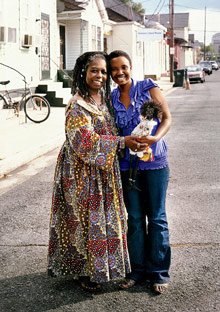
Rukiya and Brigitte in the Treme;
Photo: Katherine Wolkoff
Photo: Katherine Wolkoff
With the sort of drive that could move the equator, the sisters started a small venture they called Gahaya Links and built it into a weaving cooperative of nearly 4,000 women, most of them living in tiny villages, many of them Hutus and Tutsis working side by side. Today the company sells its products to Macy's and Starbucks (in partnership with Fair Winds Trading, which helps develop markets for the world's poorest artisans). It is the kind of business Rwanda's president, Paul Kagame, believes is essential for his country's future. He sees enterprise as the key to moving beyond the need for foreign aid—and knows full well just how enterprising Rwandan women can be. Fifty-six percent of Rwanda's parliament and 37 percent of its cabinet are women—"and not just as figureheads, but making decisions," he says. "Women have proved that they are just as capable as men, and in many cases, they are doing much better."
---
At the gallery, surrounded by boldly colorful paintings, Janet helps the New Orleans women strategize on how to get their 8,ooo bracelets finished on time. Of the five designs, they decide to focus on the red-and-black one first, and start diving into the bowls of coral. As everyone strings and beads, pushing the squeezable loop of their needles through the small holes, Janet describes her favorite comfort food: matoke, a mashed plantain dish. Which leads to Rukiya Brown's secret banana pudding recipe—which leads to everyone passing around a bag of Hershey's Kisses.
As the women work, passersby in business suits peer in and ask what's going on.
---
In April 1994, 15-year-old Brigitte Nyampinga huddled in a church along with thousands of other terrified Tutsis, waiting to die.
When a neighbor arrived at the church saying that Brigitte's father and older brother had been killed, she told herself it wasn't true, trying to buy a little credit until her heart could afford to pay. But what happened afterward was something she could never have prepared for.
On April 15, the church flew apart in an explosion of grenades and gunfire. When the killing stopped, Brigitte's mother, two sisters, and two brothers lay strewn among the pews and Bibles, somewhere in the human discard. "I couldn't really have any feeling," she says. "I was almost dead."
At the Red Cross Hospital—where one of the attackers took her, promising to kill her later—she lay in bed with a machete wound to the shoulder. Hutu militia came and murdered patients randomly. Even worse, for Brigitte, were their menacing threats of rape. A machete was one thing, but the idea of a Hutu driving his hate into her like a stake in the ground, boring through the only thing she had left, her dignity—that was unbearable.
A Hutu woman on staff took a kind eye to Brigitte, and convinced two watchmen to lock her in a storage room so she'd be safe. But the first night, the men let themselves in with clear intentions. Ndabyanze—I refuse—she kept telling them. They beat her with machetes, then took her by the legs. "To me," she says, "that was the end of my world."
The Hutu woman, seeing her mistake, arranged an escape over the hospital's barbed wire fence. But outside, there was no safe place for a Tutsi girl. After a few days, Brigitte found a prayer meeting. It was there that a neighbor who had participated in the attack on the church spotted her. He forced her home with him, into his bed, and kept her as a sex slave. Within weeks she was pregnant. She was alive, but what did that mean, she asked herself, if you went to church only to be murdered, or to the hospital just to get raped?
At the gallery, surrounded by boldly colorful paintings, Janet helps the New Orleans women strategize on how to get their 8,ooo bracelets finished on time. Of the five designs, they decide to focus on the red-and-black one first, and start diving into the bowls of coral. As everyone strings and beads, pushing the squeezable loop of their needles through the small holes, Janet describes her favorite comfort food: matoke, a mashed plantain dish. Which leads to Rukiya Brown's secret banana pudding recipe—which leads to everyone passing around a bag of Hershey's Kisses.
As the women work, passersby in business suits peer in and ask what's going on.
In April 1994, 15-year-old Brigitte Nyampinga huddled in a church along with thousands of other terrified Tutsis, waiting to die.
When a neighbor arrived at the church saying that Brigitte's father and older brother had been killed, she told herself it wasn't true, trying to buy a little credit until her heart could afford to pay. But what happened afterward was something she could never have prepared for.
On April 15, the church flew apart in an explosion of grenades and gunfire. When the killing stopped, Brigitte's mother, two sisters, and two brothers lay strewn among the pews and Bibles, somewhere in the human discard. "I couldn't really have any feeling," she says. "I was almost dead."
At the Red Cross Hospital—where one of the attackers took her, promising to kill her later—she lay in bed with a machete wound to the shoulder. Hutu militia came and murdered patients randomly. Even worse, for Brigitte, were their menacing threats of rape. A machete was one thing, but the idea of a Hutu driving his hate into her like a stake in the ground, boring through the only thing she had left, her dignity—that was unbearable.
A Hutu woman on staff took a kind eye to Brigitte, and convinced two watchmen to lock her in a storage room so she'd be safe. But the first night, the men let themselves in with clear intentions. Ndabyanze—I refuse—she kept telling them. They beat her with machetes, then took her by the legs. "To me," she says, "that was the end of my world."
The Hutu woman, seeing her mistake, arranged an escape over the hospital's barbed wire fence. But outside, there was no safe place for a Tutsi girl. After a few days, Brigitte found a prayer meeting. It was there that a neighbor who had participated in the attack on the church spotted her. He forced her home with him, into his bed, and kept her as a sex slave. Within weeks she was pregnant. She was alive, but what did that mean, she asked herself, if you went to church only to be murdered, or to the hospital just to get raped?
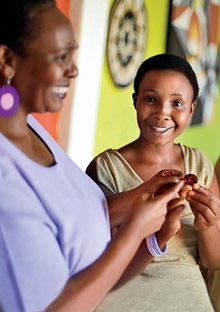
Joy (left) and Brigitte (center)
When Brigitte told her story to the women at Stella's gallery, with Janet translating, the tide of warmth that washed out from them almost capsized her. It was the Rwandan women's first night in town, and Stella had summoned her artists for a welcoming party, commanding: "Show them the love!"
And the women did, gathering around Brigitte, taking her hands, touching her face. Although she's 30, her skin is smooth as a girl's—as if, upon meeting up with the machete blade 15 years ago, her body closed for business, just stopped aging in its tracks. When she tearfully explained that she'd lost every member of her family, the group, without seeming to move, surrounded her and took hold.
"You have family now," said Rose Bratcher, a painter, walking up to hug her.
"You're so beautiful," added Herreast Harrison, one of the city's well-known beaders, taking Brigitte's face in her hands.
Stella came forward with two fancy umbrellas—a New Orleans tradition—and handed one to each of the guests, declaring, "We're all under the same umbrella."
And soon Ausettua Amor Amenkum, the gravelly voiced leader of an Africa-influenced dance company, had everyone in a circle clapping and chanting: "We say Ashe, we say Ashe because there is power in sisters being together. We thank you, Brigitte, for coming."
---
Wandering through the gallery after the welcome festivities ebbed, Brigitte and Janet stopped in one of the small side rooms, where they were captivated by a two-foot mannequin-like figure behind glass. The piece is called Unforgivable Blackness: a young, pitch-dark woman with big lips, high cheekbones, and wild explosions of hair, wearing a ruffled, lacy white wedding dress, her eyes closed in a way that suggests an uneasy vulnerability. It is one of Rukiya's dolls.
Rukiya Brown, who has just turned 57, has been making dolls since she was a girl in Chicago. She comes from a large family—eight brothers and sisters by four different fathers—and was raised by a mother who worked as a maid and switched price stickers at the supermarket because it was the only way she could afford to put meat on the table. The family moved to New Orleans when Rukiya was 15. That year, despite her mother's salvos about not falling for the first man who "showed his teeth," Rukiya ended up dating just such a man and eventually got pregnant. People said her boyfriend was "too fast" for her, and she found out just how fast he was when she caught him sneaking off to see his twin babies—same age as Rukiya's daughter—and their mother, another girl in another housing project.
Still, Rukiya married him and they moved to England after he joined the air force. She pulled herself together there, working in promotions for the base, studying textiles and design in London. But he'd had one too many affairs, and when she got back to New Orleans in 1995, she decided she was done with him, and got busy making dolls.
And the women did, gathering around Brigitte, taking her hands, touching her face. Although she's 30, her skin is smooth as a girl's—as if, upon meeting up with the machete blade 15 years ago, her body closed for business, just stopped aging in its tracks. When she tearfully explained that she'd lost every member of her family, the group, without seeming to move, surrounded her and took hold.
"You have family now," said Rose Bratcher, a painter, walking up to hug her.
"You're so beautiful," added Herreast Harrison, one of the city's well-known beaders, taking Brigitte's face in her hands.
Stella came forward with two fancy umbrellas—a New Orleans tradition—and handed one to each of the guests, declaring, "We're all under the same umbrella."
And soon Ausettua Amor Amenkum, the gravelly voiced leader of an Africa-influenced dance company, had everyone in a circle clapping and chanting: "We say Ashe, we say Ashe because there is power in sisters being together. We thank you, Brigitte, for coming."
Wandering through the gallery after the welcome festivities ebbed, Brigitte and Janet stopped in one of the small side rooms, where they were captivated by a two-foot mannequin-like figure behind glass. The piece is called Unforgivable Blackness: a young, pitch-dark woman with big lips, high cheekbones, and wild explosions of hair, wearing a ruffled, lacy white wedding dress, her eyes closed in a way that suggests an uneasy vulnerability. It is one of Rukiya's dolls.
Rukiya Brown, who has just turned 57, has been making dolls since she was a girl in Chicago. She comes from a large family—eight brothers and sisters by four different fathers—and was raised by a mother who worked as a maid and switched price stickers at the supermarket because it was the only way she could afford to put meat on the table. The family moved to New Orleans when Rukiya was 15. That year, despite her mother's salvos about not falling for the first man who "showed his teeth," Rukiya ended up dating just such a man and eventually got pregnant. People said her boyfriend was "too fast" for her, and she found out just how fast he was when she caught him sneaking off to see his twin babies—same age as Rukiya's daughter—and their mother, another girl in another housing project.
Still, Rukiya married him and they moved to England after he joined the air force. She pulled herself together there, working in promotions for the base, studying textiles and design in London. But he'd had one too many affairs, and when she got back to New Orleans in 1995, she decided she was done with him, and got busy making dolls.
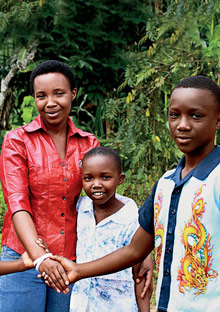
Brigitte and two of her children, Divine, and Eric
Rukiya met Stella at the New Orleans Jazz Fest in 2002. "She had a booth and was selling her dolls, and I was just awed by them," Stella says. (She has since given Rukiya two gallery shows, and Rukiya still can't believe it. "I had no idea I was an artist.")
Stella met Janet the morning of the welcome party. Within minutes, they'd sized each other up with a flash of kindred-spirit recognition. Aside from having defied expectations professionally, they're both proud of the children they've raised. (Stella reeled off the occupations of her four—corporate attorney, foreign-service generalist in the state department, pediatric dentist, Wall Street bond trader—and Janet quickly countered: eldest daughter going into her second year at the Harvard Kennedy School, first-born son a music DJ at a radio station, the younger three at home, excelling or else.) The two women also share an unquestioned commitment to helping their sisters—the Rukiyas and Brigittes of the world.
Janet met Brigitte last year in Kinyinya, a community built by the Rwandan government for the most severely psychologically traumatized genocide victims. Janet had gone there to volunteer and found Brigitte and her three children—all the result of rape—listlessly making do in a mud-brick shelter. Janet has big dreams for Brigitte. She taught her to weave baskets and disks for O Bracelets. But migraines and depression—which have plagued Brigitte since the genocide—sometimes make it hard for her to work. As a result, two to three days a week, she and her children still go without food.
---
At O bracelet central, there have been a series of problems: First the stretchy cord was too thick to thread through the holes in some of the beads. Then the sumptuous red of the coral turned out to travel—onto one's wrist! (Fair Winds Trading goes off to find different cord, and then replacement beads—no-bleed red glass.) And finally, what kind of knot is best to secure the beaded bands? (An overhand knot is the strongest but, because of the bead placement, not feasible. It will have to be a half-hitch. Make that three half-hitches.)
One day, to give everyone a break from beading, Rukiya invites Janet and Brigitte to please come over to her place if they'd like to see more dolls. A few days later, seven or eight of the New Orleans women escort their Rwandan guests to Rukiya's apartment in a clapboard house with peeling pink paint, a 20-minute walk from the gallery. Rukiya doesn't have a doorbell, so the women holler for her, then settle on the stoop, swapping stories and telling jokes.
Rukiya comes to the door, ushers Brigitte and Janet in, and leads them through the cramped apartment. Dolls are everywhere—standing on shelves, ledges, and windowsills, propped in corners, hanging from the wall. The latest figures are made in honor of the women of Congo, who are being gruesomely raped in a drawn-out ethnic war that originally spilled over from the Rwandan genocide.
Stella met Janet the morning of the welcome party. Within minutes, they'd sized each other up with a flash of kindred-spirit recognition. Aside from having defied expectations professionally, they're both proud of the children they've raised. (Stella reeled off the occupations of her four—corporate attorney, foreign-service generalist in the state department, pediatric dentist, Wall Street bond trader—and Janet quickly countered: eldest daughter going into her second year at the Harvard Kennedy School, first-born son a music DJ at a radio station, the younger three at home, excelling or else.) The two women also share an unquestioned commitment to helping their sisters—the Rukiyas and Brigittes of the world.
Janet met Brigitte last year in Kinyinya, a community built by the Rwandan government for the most severely psychologically traumatized genocide victims. Janet had gone there to volunteer and found Brigitte and her three children—all the result of rape—listlessly making do in a mud-brick shelter. Janet has big dreams for Brigitte. She taught her to weave baskets and disks for O Bracelets. But migraines and depression—which have plagued Brigitte since the genocide—sometimes make it hard for her to work. As a result, two to three days a week, she and her children still go without food.
At O bracelet central, there have been a series of problems: First the stretchy cord was too thick to thread through the holes in some of the beads. Then the sumptuous red of the coral turned out to travel—onto one's wrist! (Fair Winds Trading goes off to find different cord, and then replacement beads—no-bleed red glass.) And finally, what kind of knot is best to secure the beaded bands? (An overhand knot is the strongest but, because of the bead placement, not feasible. It will have to be a half-hitch. Make that three half-hitches.)
One day, to give everyone a break from beading, Rukiya invites Janet and Brigitte to please come over to her place if they'd like to see more dolls. A few days later, seven or eight of the New Orleans women escort their Rwandan guests to Rukiya's apartment in a clapboard house with peeling pink paint, a 20-minute walk from the gallery. Rukiya doesn't have a doorbell, so the women holler for her, then settle on the stoop, swapping stories and telling jokes.
Rukiya comes to the door, ushers Brigitte and Janet in, and leads them through the cramped apartment. Dolls are everywhere—standing on shelves, ledges, and windowsills, propped in corners, hanging from the wall. The latest figures are made in honor of the women of Congo, who are being gruesomely raped in a drawn-out ethnic war that originally spilled over from the Rwandan genocide.
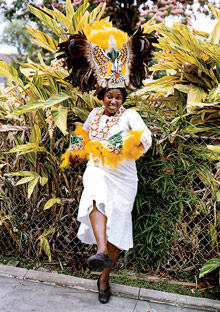
Ausettua in her handmade suit;
Photo: Katherine Wolkoff
Photo: Katherine Wolkoff
Brigitte asks why the Congo dolls have shards of mirror for eyes.
"To show that if it can happen to them, it can happen to you," Rukiya says, motioning her to sit on the couch.
"What pain, what sorrows, do you have in your life that have driven you?" Brigitte asks, looking around.
"I, too, was raped," Rukiya says, leaning closer. "Many, many times. There was no baby, but it was still a violation. And I was 13, 14. And I didn't talk about it to anyone for 30 years."
"How many were there?" Brigitte asks.
"Ten. And afterward, everywhere I went, people would say, 'Oh, there's that girl that got a train pulled on her.' It got to a point where I just would not feel anything."
"Even to this year, I don't have any desire," Brigitte says, looking down at her hands. "I can flirt with a man, but once he crosses the line, I become someone else. All I want to do is bite him—and if I had a knife, I'd cut him. I'm only 30, and I would like to be in love someday, but I can't."
"That's me, too. And it was hard to share affection with my kids," says Rukiya, whose son is serving a ten-year prison sentence for dealing drugs, while her daughter ended up going to San Jose State and becoming a child therapist.
"It's still very hard for me to accept my children," Brigitte admits. "I love them, but I don't have the heart to be their mother. Sometimes I'll take the food I'm cooking and throw it away because I'm just angry. "
"We may have to go through more pain than other people," Rukiya says. "But out of making dolls, I find a peace. All of us have a gift that God gives us. And you, Brigitte, are a weaver."
---
Before the week is over, many of the New Orleans women offer their hospitality. At the homes of Herreast Harrison and Joyce Montana, Brigitte and Janet get a glimpse of a local African-American tradition: the handmade costumes worn on Mardi Gras. The "suits," as they are known, are stunning cascades of wildly colored feathers and bravura beading that take a whole year to design and fabricate, usually involving a full family effort. The way the women describe it, when you step into a suit to join the parade, you are transformed. You become your heritage. You reach deep into your African roots.
Brigitte and Janet are deeply moved by what has been lost in New Orleans. Both are overwhelmed by seeing street after street of rotting, abandoned houses and patches of dirt where libraries and schools once stood. One afternoon, driving through the Lower Ninth Ward with a few of their hosts, the car stops where the levee broke. The women look up at the street sign.
Sister Street.
"When I am here, I don't feel like I'm an African," Janet suddenly says. "I feel like I am one of you."
Everyone in the car hugs, arms encircling arms, until it's hard to tell where one woman begins and another ends. Because what started as a project to make bracelets has turned into something more—the creation of a band of sisters.

Meet the New Orleans
designers
"To show that if it can happen to them, it can happen to you," Rukiya says, motioning her to sit on the couch.
"What pain, what sorrows, do you have in your life that have driven you?" Brigitte asks, looking around.
"I, too, was raped," Rukiya says, leaning closer. "Many, many times. There was no baby, but it was still a violation. And I was 13, 14. And I didn't talk about it to anyone for 30 years."
"How many were there?" Brigitte asks.
"Ten. And afterward, everywhere I went, people would say, 'Oh, there's that girl that got a train pulled on her.' It got to a point where I just would not feel anything."
"Even to this year, I don't have any desire," Brigitte says, looking down at her hands. "I can flirt with a man, but once he crosses the line, I become someone else. All I want to do is bite him—and if I had a knife, I'd cut him. I'm only 30, and I would like to be in love someday, but I can't."
"That's me, too. And it was hard to share affection with my kids," says Rukiya, whose son is serving a ten-year prison sentence for dealing drugs, while her daughter ended up going to San Jose State and becoming a child therapist.
"It's still very hard for me to accept my children," Brigitte admits. "I love them, but I don't have the heart to be their mother. Sometimes I'll take the food I'm cooking and throw it away because I'm just angry. "
"We may have to go through more pain than other people," Rukiya says. "But out of making dolls, I find a peace. All of us have a gift that God gives us. And you, Brigitte, are a weaver."
Before the week is over, many of the New Orleans women offer their hospitality. At the homes of Herreast Harrison and Joyce Montana, Brigitte and Janet get a glimpse of a local African-American tradition: the handmade costumes worn on Mardi Gras. The "suits," as they are known, are stunning cascades of wildly colored feathers and bravura beading that take a whole year to design and fabricate, usually involving a full family effort. The way the women describe it, when you step into a suit to join the parade, you are transformed. You become your heritage. You reach deep into your African roots.
Brigitte and Janet are deeply moved by what has been lost in New Orleans. Both are overwhelmed by seeing street after street of rotting, abandoned houses and patches of dirt where libraries and schools once stood. One afternoon, driving through the Lower Ninth Ward with a few of their hosts, the car stops where the levee broke. The women look up at the street sign.
Sister Street.
"When I am here, I don't feel like I'm an African," Janet suddenly says. "I feel like I am one of you."
Everyone in the car hugs, arms encircling arms, until it's hard to tell where one woman begins and another ends. Because what started as a project to make bracelets has turned into something more—the creation of a band of sisters.

Meet the New Orleans
designers




